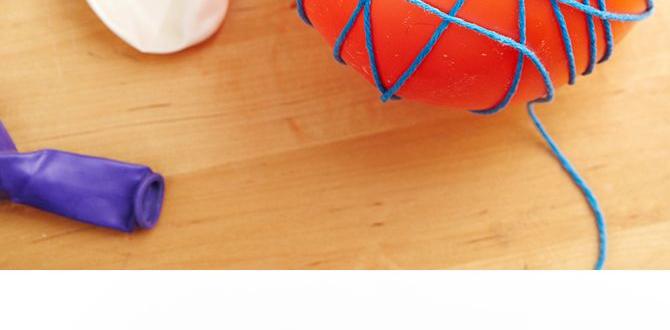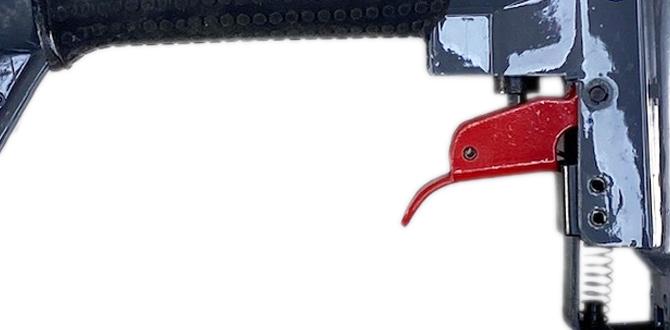Quick Summary: Worn-out O-rings in your nail gun cause inconsistent firing, air leaks, and reduced power. Regularly inspect and replace them by checking for cracks, tears, or a flattened shape. This guide shows you how to spot these signs and maintain your nailer for reliable performance.
Hey there, fellow DIYers and woodworking enthusiasts! Jack Shaffer here from Nailerguy, and I know how frustrating it can be when your trusty nail gun starts acting up. You pull the trigger, and… nothing, or maybe just a weak little puff of air. Often, the culprit isn’t some complex mechanical failure, but a simple, small rubber ring called an O-ring. These little guys are the unsung heroes of pneumatic tools, keeping air from escaping and ensuring smooth operation. When they wear out, your nailer loses its punch and can become quite unreliable. But don’t worry! Identifying worn-out O-rings is usually straightforward. We’ll walk through the signs to look for so you can get your nail gun back to its powerful, dependable self.
In this guide, we’ll cover everything you need to know to become an O-ring detective for your nail gun. We’ll explore why these parts matter, the tell-tale signs of wear, and how you can best check them. By the end, you’ll feel confident in spotting a failing O-ring and know what steps to take next!
Table of Contents
Why O-Rings Matter in Your Nail Gun
O-rings are essentially rubber or synthetic seals. In your nail gun, they create airtight barriers between moving parts. Think of them like tiny, flexible gaskets. When the piston moves, or the air valve actuates, these O-rings ensure that the compressed air used to drive the nail is contained and directed precisely where it needs to go. Without them, that precious air would just leak out, leading to a whole host of problems.
A good O-ring is slightly pliable and forms a tight seal when compressed. Over time, though, lubricants, air, and the constant movement can take their toll. This wear can be gradual or surprisingly quick depending on how often and how intensely you use your tool, as well as if you’re using the correct lubricants. Understanding their role is the first step to appreciating why keeping them in good shape is crucial for your nail gun’s performance and longevity.
The Silent, Gradual Decline: How O-Rings Fail
O-ring failure isn’t usually a sudden, dramatic event. More often, it’s a slow decline in performance that can leave you scratching your head. As the O-ring wears down, it starts to lose its flexibility and sealing ability. This can manifest in several ways:
- Drying Out: Exposure to air, especially in dry environments or with prolonged storage, can cause the rubber to dry out and become brittle.
- Compression Set: Over time, the O-ring can be permanently deformed from being under constant pressure. It loses its ability to spring back into its original shape.
- Abrasion: Tiny particles of dust, debris, or even metal shavings from moving parts can rub against the O-ring, gradually wearing grooves into its surface.
- Chemical Degradation: Some lubricants, especially if they aren’t specifically designed for pneumatic tools, can break down the rubber over time.
These factors combine to weaken the seal. A seal that’s not as tight as it should be means that not all the air pressure generated by your compressor is being efficiently used to drive the nail. This is where you start noticing performance issues.
Signs of Worn-Out O-Rings: What to Look For
Now, let’s get down to the nitty-gritty. How can you tell if those little rubber rings are the cause of your nail gun’s woes? There are several key indicators to watch out for. The best approach is to be observant, both when the tool is in use and when you’re doing routine maintenance.
1. Leaking Air
This is often the most obvious sign. If you hear a hissing sound when the nail gun is idle, or even when it’s connected to air but not firing, you likely have an air leak. O-rings are prime suspects for these leaks because they seal the cylinders and air passages. A compromised O-ring allows compressed air to escape before it can do its job.
Where to listen: Pay close attention to any seams or junctions on your nail gun. Common culprits include:
- The area where the magazine meets the body of the nailer.
- Around the trigger assembly.
- Where the air hose connects (though this is often the coupler itself, a leak further inside could still originate from an O-ring).
It’s important to differentiate between a leak at the air hose coupler and an internal leak. An internal hiss means you’ve likely got a problem within the tool itself, and O-rings are a very common cause.
2. Inconsistent Firing Power
Does your nail gun sometimes drive nails flush, but other times leaves them proud of the surface, even when you haven’t changed any settings? This is a classic symptom of insufficient air pressure reaching the piston. When an O-ring is worn, it doesn’t seal as effectively, meaning less compressed air is available to push the piston and driver blade with full force. This leads to unpredictable and weak nail drives.
You might notice:
- Nails not fully seating into the wood.
- Nails getting jammed more frequently.
- A general feeling of “laziness” from the tool, as if it’s not hitting as hard as it used to.
This inconsistency is not only frustrating but can also lead to work that looks unprofessional and requires extra time for rework.
3. Trigger Malfunctions or Slow Return
A properly functioning nail gun has a responsive trigger. If you notice the trigger feeling sluggish, especially during or after firing, or if it doesn’t snap back quickly to its reset position, worn O-rings could be involved. The air pressure that powers the trigger reset mechanism relies on these seals.
A worn O-ring in the trigger assembly can:
- Allow air to leak away that should be helping the trigger reset.
- Cause the trigger mechanism itself to feel “mushy” due to internal air loss.
While other parts of the trigger assembly can also cause issues, O-rings are a frequent contributor to these kinds of performance degradations.
4. The Nail Gun Feels “Weak” or Lacks “Punch”
This is a more general symptom but is highly indicative of an air leak somewhere within the tool. If your nail gun just doesn’t seem to hit as hard as it once did, even with full compressor pressure and the depth adjustment set to its maximum, an O-ring issue is a strong possibility. The O-rings inside the cylinder and around the piston’s movement are critical for containing the air charge that drives the nail. When they fail, that driving force is diminished.
Think of it like a leaky balloon. You can blow it up, but if there’s a small hole, it won’t hold its pressure nearly as well. Your nail gun operates on a similar principle, using compressed air as its “muscle.”
5. Overheating or Excessive Noise
While less common as a primary O-ring symptom, significant leaks can sometimes cause a nailer to work harder than it needs to, potentially leading to increased operational noise or even slight overheating. The tool’s motor or pneumatic system might be cycling more frequently or working under suboptimal conditions to compensate for lost air. This isn’t the most direct sign, but if you combine it with other symptoms, it adds to the case for an O-ring inspection.
How to Inspect O-Rings: A Step-by-Step Approach
Okay, you’ve noticed some of the symptoms. Now, let’s get hands-on. Most O-ring replacements in nail guns are a DIY-friendly task if you’re comfortable with basic tool disassembly. Remember to always unplug your tool from the air source before beginning any maintenance to prevent accidental firing and injury.
Safety First!
Before you even think about picking up a screwdriver, ensure your nail gun is completely disconnected from its air compressor. This is a non-negotiable safety step. Also, make sure you’re working in a well-lit area. Having a clean workspace will prevent tiny screws or O-rings from getting lost.
Step 1: Gather Your Tools
You won’t need a toolbox full of specialized equipment for most O-ring replacements. Here’s what you’ll likely need:
- Screwdrivers: Phillips and flathead, in various sizes. Check your nail gun’s manual for specific types or look at the screws themselves.
- Hex Keys (Allen Wrenches): Some nail guns use these for disassembly.
- Pliers: Needle-nose pliers can be helpful for gripping small parts.
- O-ring Pick Set or Small, Flat Tool: For gently prying out old O-rings without damaging the metal or plastic housing. A small, flat-head screwdriver can work, but be very careful.
- Replacement O-rings: It’s crucial to get the correct size and material for your specific nail gun model.
- Suitable Lubricant: A small amount of specific pneumatic tool oil or a manufacturer-recommended lubricant.
- Clean Rags: For wiping down parts.
- Your Nail Gun’s Manual: This is invaluable for specific disassembly and reassembly instructions.
Getting the right replacement O-rings is vital. They need to be the exact diameter and cross-section, and made of a material compatible with the tool’s operating environment. You can usually find part numbers in your tool’s manual or on the manufacturer’s website. Many brands also sell O-ring rebuild kits for popular models.
Step 2: Disassemble the Nail Gun (Carefully!)
This is where your nail gun’s manual becomes your best friend. Follow its instructions precisely. Generally, you’ll be looking to access the parts where leaks are most common or where the piston and driver blade mechanism is housed.
Common disassembly areas include:
- The Nose/Tip Assembly: This is where the driver blade emerges. It often has seals around the piston or guide.
- The Top or Rear Cap: This often provides access to the main piston and related air seals.
- The Trigger Housing: Sometimes accessible without full disassembly.
As you take the nail gun apart, pay attention to the order and orientation of each part. Taking photos with your phone as you go can be incredibly helpful for reassembly. Lay out the parts logically on your clean rag workspace.
Step 3: Locate and Inspect the O-Rings
Once you have access to the internal components, look for the rubber rings. They’ll typically be seated in grooves around cylindrical parts (like pistons or plungers) or within housing cavities.
Here’s what to look for when inspecting an O-ring:
| Sign of Wear | What to Look For | Impact on Nail Gun |
|---|---|---|
| Cracking or Splitting | Visible linear cracks or small tears on the surface or sides. | Major air leaks, complete loss of power. |
| Flattening or De-shaping | The circular cross-section appears squashed or no longer round. | Reduced sealing capacity, inconsistent power, leaks. |
| Hardening or Brittleness | The rubber feels cứng and inflexible, may chip or break if bent. | Poor sealing, prone to cracking under pressure, leaks. |
| Grooves or Nicking | Scratches, gouges, or indents on the O-ring surface. | Air bypass, reduced power, potential for debris to get past the seal. |
| Discoloration or Swelling | The O-ring has changed color significantly or looks puffy/enlarged. | Can indicate chemical degradation, leading to loss of sealing properties. |
Use your O-ring pick or a suitable tool to gently lift and remove each O-ring. Be careful not to scratch the metal or plastic grooves they sit in. Once removed, you can inspect them more closely. If ANY of the signs of wear mentioned above are present, it’s time to replace that O-ring.
Step 4: Replacing the O-Rings
If you found a worn-out O-ring, it’s time for the replacement. Take the old O-ring with you to the hardware store or look up its dimensions online to ensure you get an exact match. Don’t try to force an O-ring that is too big or too small.
Here’s how to install the new one:
- Clean the Groove: Make sure the groove where the O-ring sits is perfectly clean. Use a rag to wipe away any debris, old lubricant, or rubber residue.
- Lubricate the New O-ring: Apply a very thin, even coat of appropriate lubricant to the new O-ring. This helps it slide into place without tearing and ensures a good seal right away. Use only lubricants specified for pneumatic tools; standard petroleum jelly can degrade rubber over time.
- Install the O-ring: Carefully place the new O-ring into its groove. You can often roll it into place. Use your fingers or a very gentle tool to seat it completely and ensure it’s not twisted.
- Reassemble the Tool: Follow your manual’s disassembly photos or diagrams in reverse order to put your nail gun back together. Ensure all parts are correctly aligned and re-secured. Don’t overtighten screws, which can strip threads or crack plastic.
It’s often a good idea to replace all O-rings in a specific section at once. If one is worn, others in the same assembly are likely close to the end of their life too. This proactive approach can save you from having to disassemble the tool again soon.
Step 5: Test and Refine
Once your nail gun is fully reassembled, reconnect it to your air compressor. Listen carefully for any hissing sounds. If you hear any leaks, you may need to go back and check your O-ring installation or O-ring seating. If all sounds good, test fire the tool into a piece of scrap wood. Check the nail depth and consistency. It should feel responsive and powerful again!
If you’re still experiencing issues, you might have missed a different worn O-ring, or the problem could lie with another component. Consulting the manufacturer’s troubleshooting guide or a professional can be the next step in that case.
When Should You Consider Professional Help?
While many O-ring replacements are straightforward, there are times when it’s best to seek professional help:
- You’re Uncomfortable with Disassembly: If taking apart your nail gun feels beyond your comfort zone, it’s perfectly fine to take it to a tool repair shop.
- Specialized Tools Required: Some high-end or specialized nail guns might require specific tools or technical knowledge for disassembly.
- Persistent Problems: If you’ve replaced the O-rings and are still experiencing issues, there might be a more complex problem that requires expert diagnosis.
- Warranty Concerns: If your tool is still under warranty, attempting self-repair might void it. Always check your warranty terms.
A qualified tool repair technician has the experience and parts to get your nail gun back in top shape without you having to worry.
Preventative Maintenance Tips
The best way to deal with worn-out O-rings is to prevent them from wearing out too quickly. Incorporating a few simple maintenance steps can extend the life of your nail gun significantly.
- Regular Lubrication: Use only the type of lubricant recommended by the manufacturer. Apply it as directed. This keeps the O-rings supple and seals them properly. For pneumatic tools requiring oil, a few drops per day of use into the air inlet is typically sufficient. For oil-free designs, internal lubrication is usually handled by specific compounds on the O-rings themselves, so avoid adding oil.
- Cleanliness is Key: Keep your nail gun clean, especially around the magazine and air inlet. Dust and debris can get pushed past O-rings and cause abrasion. Wipe down the exterior regularly.
- Proper Air Pressure: While your compressor should be set correctly, ensure your nail gun is working within its recommended operating pressure range. Too high or too low pressure can stress components. Check operating pressure specs from reputable sources like the Occupational Safety and Health Administration (OSHA) regarding pneumatic tool safety.
- Storage: When storing your nail gun for extended periods, especially in humid or very dry conditions, consider storing it in a case with a desic




